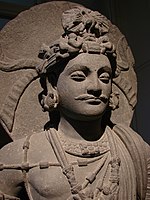Pagri (turban)
Pagri, sometimes also transliterated as pagari, is the term for

Cloth
A pagri is usually a long plain unstitched cloth. The length may vary according to the type. The cloth indicates the region and the community of the wearer.[2]
Specific styles
Baul
khirki-dār-pagari
Methods of binding the pagri are innumerable, and khirki-dar-pagri is one particular style of dressing the turban. Khirki-dar-pagri means the turban with a window. Brocade piece may decorate the turban.[5]
Paag
The paag is a headdress in the
Pheta
Pheta is the
There are several styles of Pheta which are specific to regions, for example
- pheta
- Mawali pagadi (traditionally worn by Maratha warriors from the Mawal region of Maharashtra)
- Mahatma Phule pagadi famously worn by the Maharashtrian reformer, the activist from whom it gets the name.[7]

Peta
The peta is a turban worn in
Administrators under the
After India became independent in 1947 and the princely state merged with the Indian union, the traditional Mysore peta has been retained as a symbol of heritage and cultural antecedents and distinguished people are honoured by the award of a Mysore peta with a shawl in formal functions.
Rajasthani pagari


Turbans worn in Rajasthan are referred to as the pagari and is also pronounced pagri. They vary in style, colour and size. They also indicate a wearer's social class, caste, region and the occasion it being worn for. Its shape and size may also vary with the climatic conditions of the different regions. Turbans in the hot desert areas are large and loose. Farmers and shepherds, who need constant protection from the elements of nature, wear some of the biggest turbans. The Rajasthani turban also has many practical functions. Exhausted travellers use it as a pillow, a blanket or a towel. It can be used to strain muddy water. An unravelled turban can also be used as a rope to draw water from a well with a bucket.[8]
Prominent styles are pencha, sela and safa, although several local variants exist. A conventional pagari is usually 82 inches long and 8 inches wide. A Safa is shorter and broader. Ordinarily a turban of a single colour is worn. However, turbans of one of more colours may be worn by the elite or during special occasions such as festivals or weddings, etc.[9] Rajasthani turbans are a prominent tourist attraction. Tourists are often encouraged to participate in turban-tying competitions.[8]
Peshawari pagri
Peshawari pagri has been traditionally worn in Peshawar. It includes a cap called kulla and the cloth wrapped around it called lungi.[10]
Association with figure of speech
A pagri is a symbol of honour and respect in all the regions where it is a practice to wear one. Its association with honour also lends its use in a figure of speech in associated languages. The figure of speech pagri uchaalna in Hindi (literal translation: to toss the turban) implies causing the loss of honour.[citation needed]
Recognition of communities
Different communities in Rajasthan are recognized by the colours and patterns on their pagris. The Kevat community wears only red Bandhani turban at all occasions. Jat community in Narwa village wears a bright yellow turban.[11]
Pagri in Ancient India: from major museums
-
The Great Departure of Buddha, Victoria and Albert Museum
-
Proto-Pagri, Kushan-Gupta period, 5th-6th century CE, terracotta, Honolulu Academy of Arts
-
Walters Art Museum, Baltimore
See also
References
- S2CID 258804155.
- ^ "Pride of tying Turbans". Travelersinduia.com. Archived from the original on 30 December 2019. Retrieved 2 March 2010.
- ^ "Project ABCD".
- ^ "Baul - Banglapedia".
- ISBN 978-0-8108-7785-6.
- ^ "Kolhapuri Pheta". Kolhapur World. Archived from the original on 2 October 2012.
- ^ "From baseball caps to phetas!". 13 June 2009.
- ^ a b "Rajasthan at a glance". Rajasthanunlimited.com. Archived from the original on 16 March 2013. Retrieved 3 March 2010.
- ^ "Rajasthan traditional dresses". greatindianholiday.com. Archived from the original on 18 September 2009. Retrieved 3 March 2010.
- ^ Title Subhas Chandra Bose: Netaji's passage to im[m]ortality, Subodh Markandeya, Arnold Publishers, 1990, p. 147
- ^ "Waves of a Desert". 12 May 2023.










